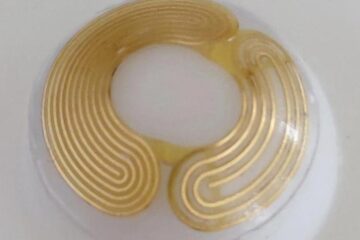NASA's Phoenix Retesting Release of Martian Soil

When the lander collected and released its first scoopful of soil on Sunday, some of the sample stuck to the scoop. The team told Phoenix this morning to lift another surface sample and release it, with more extensive imaging of the steps in the process.
“We are proceeding cautiously,” said Phoenix principal investigator Peter Smith of The University of Arizona. “Before we begin delivering samples to the instruments on the deck, we want a good understanding of how the soil behaves.”
An image of one of the analytical instruments received Monday night underscored the need for precise release of samples. It shows the two spring-loaded doors on one of the tiny ovens of the Thermal and Evolved-Gas Analyzer after a command for them to open in preparation for receiving the instrument's first soil sample. One opened fully, the other partially. Phoenix engineers said the opening is wide enough to receive a sample, and that it might still open further with daily temperature changes.
The Phoenix Mission is led by The University of Arizona, on behalf of NASA.
Project management of the mission is by NASA's Jet Propulsion Laboratory, Pasadena, Calif. Spacecraft development is by Lockheed Martin Space Systems, Denver.
For more information about Phoenix, visit http://phoenix.lpl.arizona.edu and http://www.nasa.gov/phoenix.
MEDIA CONTACTS:
Sara Hammond, UA (520-626-1974; shammond@lpl.arizona.edu) Guy Webster, JPL (818-354-5011; guy.webster@jpl.nasa.gov) Dwayne Brown, NASA Headquarters (202-358-1726; dwayne.c.brown@nasa.gov)
Media Contact
More Information:
http://www.arizona.eduAll latest news from the category: Physics and Astronomy
This area deals with the fundamental laws and building blocks of nature and how they interact, the properties and the behavior of matter, and research into space and time and their structures.
innovations-report provides in-depth reports and articles on subjects such as astrophysics, laser technologies, nuclear, quantum, particle and solid-state physics, nanotechnologies, planetary research and findings (Mars, Venus) and developments related to the Hubble Telescope.
Newest articles

‘Smart’ contact lenses could someday enable wireless glaucoma detection
Most people with early-stage glaucoma don’t know they have it, even though early treatment is key to reducing vision loss. While detecting a subtle increase in eye pressure helps doctors…

New tech may lead to smaller, more powerful wireless devices
Good vibrations… What if your earbuds could do everything your smartphone can do already, except better? What sounds a bit like science fiction may actually not be so far off….

Caution, hot surface!
An international research team from the University of Jena and the Helmholtz Institute Jena are demystifying the mechanisms by which high-intensity laser pulses produce plasma on the surface of solids….





















